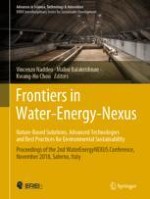This volume includes selected contributions presented during the 2nd edition of the international conference on WaterEnergyNEXUS which was held in Salerno, Italy in November 2018. This conference was organized by the Sanitary Environmental Engineering Division (SEED) of the University of Salerno (Italy) in cooperation with Advanced Institute of Water Industry at Kyungpook National University (Korea) and with The Energy and Resources Institute, TERI (India). The initiative received the patronage of UNESCO – World Water Association Programme (WWAP) and of the International Water Association (IWA) and was organized with the support of Springer (MENA Publishing Program), Arab Water Council (AWC), Korean Society of Environmental Engineering (KSEE) and Italian Society of Sanitary Environmental Engineering Professors (GITISA). With the support of international experts invited as plenary and keynote speakers, the conference aimed to give a platform for Euro-Mediterranean countries to share and discuss key topics on such water-energy issues through the presentation of nature-based solutions, advanced technologies and best practices for a more sustainable environment. This volume gives a general and brief overview on current research focusing on emerging Water-Energy-Nexus issues and challenges and its potential applications to a variety of environmental problems that are impacting the Euro-Mediterranean zone and surrounding regions. A selection of novel and alternative solutions applied worldwide are included. The volume contains over about one hundred carefully refereed contributions from 44 countries worldwide selected for the conference. Topics covered include (1) Nexus framework and governance, (2) Environmental solutions for the sustainable development of the water sector, (3) future clean energy technologies and systems under water constraints, (4) environmental engineering and management, (5) Implementation and best practices Intended for researchers in environmental engineering, environmental science, chemistry, and civil engineering. This volume is also an invaluable guide for industry professionals working in both water and energy sectors.
